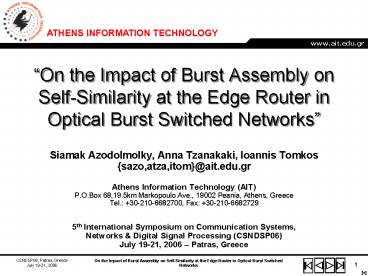CSNDSP06, Patras, Greece - PowerPoint PPT Presentation
1 / 20
Title:
CSNDSP06, Patras, Greece
Description:
On the Impact of Burst Assembly on Self-Similarity at the Edge Router in Optical ... R/S plot, aggregate variance, Periodogram, local Whittle, Wavelet ... – PowerPoint PPT presentation
Number of Views:48
Avg rating:3.0/5.0
Title: CSNDSP06, Patras, Greece
1
On the Impact of Burst Assembly on
Self-Similarity at the Edge Router in Optical
Burst Switched Networks
ATHENS INFORMATION TECHNOLOGY
- Siamak Azodolmolky, Anna Tzanakaki, Ioannis
Tomkos - sazo,atza,itom_at_ait.edu.gr
- Athens Information Technology (AIT)
- P.O.Box 68,19.5km Markopoulo Ave., 19002 Peania,
Athens, Greece - Tel. 30-210-6682700, Fax 30-210-6682729
- 5th International Symposium on Communication
Systems, - Networks Digital Signal Processing (CSNDSP06)
- July 19-21, 2006 Patras, Greece
2
Outline of Talk
- Introduction
- Optical Burst Switching (OBS) A Quick Overview
- Research Question
- Simulation Model
- Hybrid Burst Assembly
- Simulation Scenario
- Results
- Conclusion Future works
- Question Answers
3
OBS An Overview
- OBS is a transport scheme that combines the best
feature of both circuit switching and packet
switching - Various types of client data are aggregated at
the ingress node and transmitted as data bursts - The Burst Control Packet is out-of-band and
transmitted prior to the data burst - At a lower rate than the data burst
- It is processed independent of the data burst in
the electronic domain - Time offset may be used for QoS differentiation
- The client data is buffered at the edge, where
electronic buffer is cheap and abundant - The data burst is transparently switched and
routed through the network without OEO conversion
4
Burst Assembly (Aggregation)
- Timer-based (T)
- A timer starts at the beginning of each new
assembly cycle. After a fixed time T, all the
packets that arrived in this period are assembled
into a burst. - Burst size-based (L)
- Packets are assembled into a burst after a
pre-defined length L is reached. - Hybrid timer/threshold-based
- Its a technique, which combines both previous
criteria
5
Research Question
- Traffic Shaping Capabilities of the burst
assembly algorithms - Goal Suppression of self-similarity level of the
output traffic in the presence of self-similar
input traffic - Self-similar traffic sources
- Hybrid burst assembly algorithm
- Various Hurst parameter estimators are applied
- R/S plot, aggregate variance, Periodogram, local
Whittle, Wavelet - Focusing on packet-wise and burst-wise traffic
measurements along with byte-wise measurements - Important due to performance impact on control
units in core routers - Performance evaluation of the burst assembly
algorithms - Burst assembly delay
- Burst assembly delay jitter
6
OPNET Modeling Domains
- Modular and Hierarchical structure of OPNET
7
Developed Models
- Link models
- Based on OPNET point-to-point (PPP_adv) links
- Packet Format
- OBS Edge Router
- OBS Core Router
- Source Nodes
- Integration based on OPNET RPG traffic source
8
Source Nodes
- Standard raw packet generator (RPG) model
- Self-similar traffic model based on superposition
of fractal renewal point process (Sup-FRP) - Probability density function for interarrival
times
9
Source Nodes
- Self-similar traffic traces (OPNET RPG model)
- Arrival rate 100 packet/sec., Fractal Onset Time
Scale (FOTS) 0.1 sec., H0.6, 0.7, 0.8, 0.9
10
Burst Assembly Algorithm
- Hybrid Burst Assembly
- Timer Threshold
- Size Threshold
- ? and ? are parameters
- ELp is the mean IP packet length
- N Number of OBS egress routers
- M Number of sources
11
Simulation Scenario
- 12 Client networks are connected to the edge
router via 10Gbps links (M12) - Edge router is connected to the core via a 40Gbps
link - Traffic load (0.3, 0.5, 0.7)
- Client networks are divided in 4 groups(H0.7,
0.75, 0.8, 0.9) - N Destinations in core network
- N1, 10, 20
- Traffic monitoring 100 ?Sec.
- Simulation time 6 sec.
- Realistic IP packet size distribution (Average IP
packet length 375.5 byte)
12
Results H vs. Traffic Load
13
Results H vs. ?
14
Results H vs. ?
15
Burst Assembly Delay vs. ?
16
Burst Assembly Delay Jitter
17
Burst Assembly Delay vs. ?
18
Burst Assembly Delay Jitter
19
Burst Creation vs. ? and ?
20
Conclusion
- Development of related OPNET models for
performance evaluation of OBS networks - A simulation framework using OPNET models
- Realistic self-similar traffic sources
- Performance evaluation of a typical network
(assembly delay, delay jitter) - Traffic shaping capability of hybrid burst
assembly algorithm in terms of reduction in
self-similarity level of output traffic - Performance evaluation of hybrid burst assembly
algorithm in terms of burst assembly delay and
its jitter.































